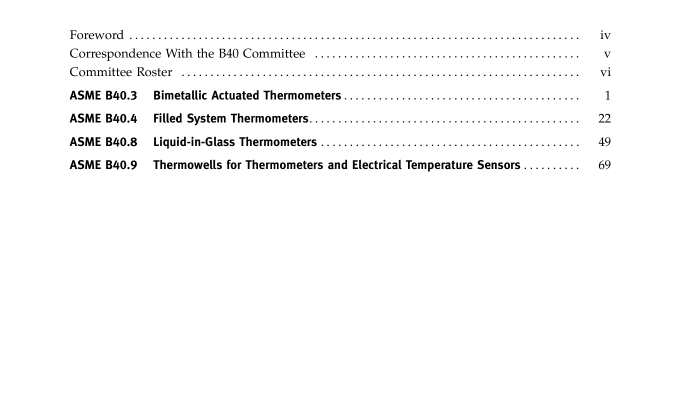ASME B40.200-2008 pdf free download.Thermometers, Direct Reading and Remote Reading
4 SAFETY 4.1 Scope This section of the Standard presents information to guide users, suppliers, and manufacturers towards min- imizing the hazards that could result from misuse or misapplication of thermometers. The user should become familiar with all sections of this Standard, as all aspects of safety cannot be covered in this section. Con- sultthe supplierforadvicewheneverthere is uncertainty about the safe application of a thermometer.
4.2 General Discussion
4.2.1 Adequate safety results from intelligentplan- ning and careful selection and installation ofa thermom- eter into a system, the temperature of which is to be measured. The user should inform the supplier of all conditionspertinentto theapplicationandsystemsenvironment so that the supplier can recommend the most suitable thermometer/attachments for that application.
4.2.2 Many applications of thermometers, particularly those with plain connectors, involve temperature measurement of unpressurized systems. In general, the principal hazards of using thermometers at ambient pressure are those associated with proximity to the system being measured (e.g., exposure to hot liquids, corrosive material, freezing fluids, etc.).
4.2.3 Safe use of a thermometer with a threaded connector in a system where the stem is not protected by a thermowell requires that factors such as the follow- ing be considered:
(a) effect of static pressure and maximum transient pressure on the stem integrity
(b) effect of temperature on material
(c) any corrosive effects on stem materials
(d) flow-induced vibration on the stem
(e) consequences of accidental breaching of the stem
4.2.4 Thermowells permit the use ofthermometers at higher pressure than could be safely applied to an unprotected stem. Thermowells facilitate the removal and reinstallation of thermometers without creating a temporary leak and without requiring process shut- down. They protect the stem from excessive tempera- tures and corrosive attack by the process medium and against structural damage caused by fluid velocityinduced vibration. To improve response time, the space surrounding the stem within the thermowell may be filled with a heat transfer medium suitable for use at the process temperature. 1 Consult the thermowell supplier for proper selec- tion and application.
4.2.5 Expansion of air or other fluids trapped in a sealed case (sealed by design or otherwise) may cause a blowout failure of the window. When high ambient temperatures are expected, such a blowout possibility should be considered. Aftera periodoftime, anonsealed case may become sealed due to an accumulation of varnish-like atmospheric contamination.
4.3 Safety Recommendations
4.3.1 Pressure and temperature ratings should be determined by the manufacturer, and an unprotected stem should not be used beyond the recommended rat- ing. Installation of any thermometer should be consistent with application codes.
4.3.2 The location of the thermometer should be such that injury to personnel and damage to property is minimized in the event of an accidental breach of stem/thermowell combination.
4.3.3 For liquidfilled thermometers, it has been general practice to use glycerin- or silicone-filling liquids. However, these fluids may not be suitable for all applications. They should be avoided where strong oxi- dizing agents, including (but not limited to) oxygen, chlorine, nitric acid, and hydrogen peroxide, are involved. In the presence of oxidizing agents, a potential hazard can result from chemical reaction, ignition, or explosion. Completely fluorinated or chlorinated fluids, or both, may be more suitable for such applications.
4.3.4 Liquid-filled thermometers may not be avail- able in all ranges because of the effect of temperature on the fill material. Since a liquidfilled, bimetallic ther- mometer is completely filled with fluid, including both its stem and case, the fill is exposed to the process tem- perature. Notonlywill the fillexpandas the temperature increases, raising pressure inside the case, but it may also degrade because of continuous exposure to extreme temperature. Because of the possibility of temperature- induced pressure inside the case, plain glass windows must not be used.ASME B40.200 pdf download.ASME B40.200-2008 pdf free download
